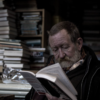As history buffs around the world will know, 2017 marks the one hundredth anniversary of U.S. entry into World War I.
In recognition of this anniversary, my state’s history center is currently sponsoring an exhibit on the lead-up to the war, America’s part in it, and the aftermath. I had the fun of exploring this exhibit the other day and came home with a couple takeaways.
The first was the realization of how much the aftermath of the World War I looks like our world today. We may think uncontrolled riots, clashes with police, and debates over race are a new thing, but truly, these are only the second (or third) verse, same as the first.
The second takeaway had more to do with what was missing rather than what was presented. As I left, I realized that I had not seen a single thing about Sergeant York. I later learned from another member of my party that there had been a tiny blurb about him in the back of one exhibit book, but even this brief shout-out seemed too minimal for an individual who was one of the most celebrated and decorated soldiers of the conflict (and has a phenomenal backstory, I might add). Instead, the exhibit included life-size posters highlighting the exploits of those who fought against race, class, gender, and political discrimination during and after the war.
Now, there is certainly nothing wrong with studying and highlighting those who performed these latter acts. They were brave souls who fought for things they believed in and won important and historical victories on the home front.
But I still found it disconcerting that an individual whom many would consider a key player in the war – and even one whose social class and originally pacifist views fit with the race, class, gender narrative – would be nearly invisible. Why was Sergeant York pushed to the background?
I hit upon one possible answer to that question while looking through Professor Anthony Esolen’s book Ten Ways to Destroy the Imagination of Your Child. As Esolen implies, we have begun to remove heroes from the lives of our children because doing so keeps them “banal and safe.” He goes on to note:
“A hero, even a fictional creation, is like a pack of dynamite, ready to blow any mountain of heaped-up conformity and dullness sky high.”
Although we don’t often say it, the underlying currents of school and society suggest that safety and conformity are the foremost goals we have for the next generation. Thus, removing all forms of heroism is a goal which can be accomplished in the following ways:
“[S]ince the likeliest place for a hero to show forth his courage is a battlefield, cast aspersions on the military ideal. This you can do by belittling the intelligence of the soldier, by preaching an easy and self-serving pacifism, and by reducing the military to a career option open for everyone, regardless of physical prowess or even sex. Second, since the hero will often do what is foolish in the eyes of the world – sailing to Molokai to minister to lepers whom all the world had shunned, or enduring the contempt of former associates while preaching against their trade in slaves, or taking a small contingent of half-starved men across the icy Delaware on a night-attack against professional soldiers at Trenton-instill in your children an easy contempt for the more difficult and fantastic virtues. Encourage the snigger rather than the cheer; the knowing smirk, rather than the flush of adoration.”
Not surprisingly, Sergeant York’s heroism was all of this: life-risking, allegedly foolish, and highly risky, but also very courageous.
Have we relegated this type of hero to the dustbins of history simply because visibility will encourage our children to do exploits which are risky and maybe even non-politically correct? And if so, are we prepared to further a society which only conforms to the popular, easy trends of life, shying away at anything which seems difficult or undesirable?
















Leave a Comment
Your email address will not be published. Required fields are marked with *